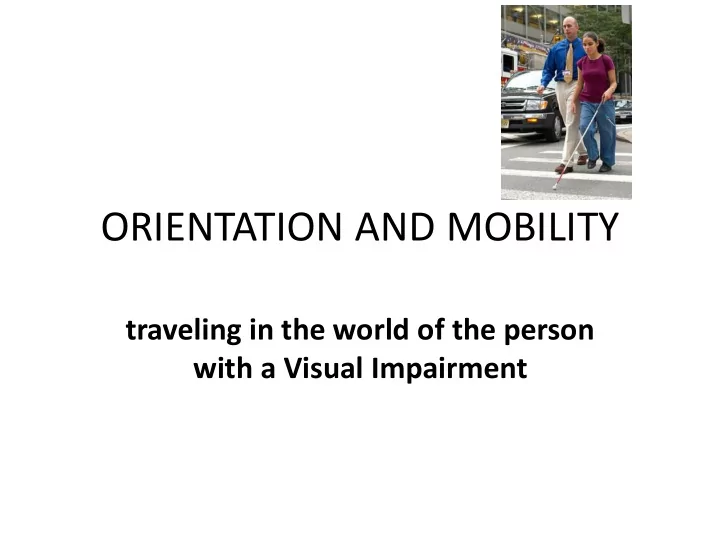

ORIENTATION AND MOBILITY traveling in the world of the person with a Visual Impairment
Objectives By the end of this seminar the participant will be able to: • Identify the role an orientation and mobility specialist plays in vision rehabilitation • Describe the importance of direct teaching with individuals with a visual impairment • Describe at least two guidance strategies • Relate the concept of the five points of travel
Orientation and Mobility (O&M) Orientation and Mobility Specialist • Orientation- Where am I? • Mobility- How do I travel to my destination? • O&M specialists address: – Skills for independent travel and community access for people with vision loss – Negotiating environment and maintaining orientation – Offer support to family and staff 3
How can someone with a visual impairment travel safely? ● Wheelchair ● White cane ● Sighted/human guide ● Walker
The vision team • Optometrists • Ophthalmologists • Low vision specialists • Teachers of the visually impaired (TVI) • Orientation and Mobility Specialists • Occupational Therapists • Vision Rehabilitation Therapists/Teachers • Rehabilitation counselors
Direct instruction versus incidental learning • Incidental: • Direct: (2) distance senses (3) distance senses Learning about the learning about the environment through environment through auditory scanning, scanning and movement, smell, and comparing capitalizing on any remaining vision PLUS direct instruction
COGNITIVE MAP Through incidental learning heavily supported by direct instruction, individuals build a cognitive map of the environment Individuals with visual impairment need to be taught earlier in some skills because repetition and overlearning is key to map building
Guidance • Trailing and voice guide • Human guide • White (long) cane • Dog guide • Electronic travel aids (ETA) – Sunu band (wrist band/blue tooth) – Laser cane (emits laser beams for obstacles) – Sonicguide spectacles (ultrasounds in the environment) – use with long cane/dog
HUMAN GUIDE HOW TO GUIDE A PERSON WITH A VISUAL IMPAIRMENT
Etiquette • Announce name • Describe surroundings • Speak directly to the • Verbally indicate individual at a normal surface changes volume • Inform when • Ask if assistance is destination is reached, needed describe the route • Do not push or pull • Do not leave the • Give left/right individual in open directions space 10
Basic Human Guide • Offer arm by tapping back of hand against client’s hand. • Individual grasps arm just above elbow • Firm grip • Stay 1/2 step ahead of client • Individual’s arm at 90 degrees • Relaxed and comfortable pace 11
Supported Basic Sighted Guide • If someone needs extra support, appears off balance, or uncomfortable, bend your supporting arm to 90 degrees so the individual can apply weight to your arm. 12
Changing Sides • Individual places the back of free hand just above grip on the guide's arm • Individual moves the original grip hand across guide's back to guide's other arm • Individual sidesteps into new position on guide's other side, resuming grip with the appropriate hand. 13
Doorways • Give narrow passageways signal • Indicate if door is push or pull and if it opens to left or right • Individual puts arm up to hold door • Walk through door and return to basic hold 14
Seating • Place individual ’s hand on back of seat • OR guide individual to chair so shins lightly touch front of seat • Inform if individual is in front/back of seat • Allow individual to sit 15
Stairs • Approach edge of • Individual brings toes to edge of step steps • Take the first step • Pause at edge of the • Individual follows guide's first step. pace, one step behind. • Pause after completing the stairs, announce stairs are complete 16
video of human guide • https://www.youtube.com/watch?v=tl62s2Ml KEw&list=PLpAOW00xNyybYZ7EmTk3nSvSNoP GK3r7E&index=1
White (Long) Cane A few notes about the white cane: A white cane is used in a sweeping arc to anticipate ground obstacles or drops ahead. It does not identify objects at head height. That is where upper body protective techniques or even electronic travel aids can help. Various types of canes (folding or rigid, NFB canes) and types of cane tips are used depending on the individual’s needs. An individual may choose to use the cane or not when using human guide. A white cane is NOT to be used as a support cane. Support canes can be marked with the white and red universally known markings for identification purposes but support canes are not suitable to be functionally used as a white cane.
The 5 Point Travel System For Orientation and Mobility Specialists teaching the 5 point travel system is a systematic approach that enables the individual with a visual impairment to make use of additional information when traveling in order to maintain orientation 1. The shape of the route (according to the braille cell: I shaped, L shaped, U route, Z route) 2. Compass (cardinal) direction 3. Names of streets/hallways 4. Landmarks 5. All of the above in reverse order
Other Orientation and Mobility Skills • Body alignment – body planes • Self protection techniques • Echolocation • Cane techniques • All of the above are incorporated into practical application such as – Street crossings/intersections – Walking through open space – Using public transportation – Familiarization strategies in new environments – Self advocacy
References/sources • https://www.cnib.ca/en/sight-loss-info/when- someone-you-know-blind?region=gta
references/sources • Jacobson, W.H.: 1993 The Art and Science of Teaching Orientation and Mobility to Persons with Visual Impairments, AFB Press • Weiner, W., Welsh, R., Blasch, B: 2010 Foundations of Orientation and Mobility Instructional Strategies and Practical Applications, third ed. AFB Press • Great source of video information for training and other sources: Canadian National Institute for the Blind: https://www.cnib.ca/en/sight-loss-info/when-someone-you-know- blind?region=gta • National Federation of the Blind: https://www.nfb.org • American Foundation for the Blind: https://www.afb.org • Pediatric information from the Perkins School for the Blind: https://www.perkins.org/school • Massachusetts Association for the Blind: https://www.mabcommunity.org
Recommend
More recommend